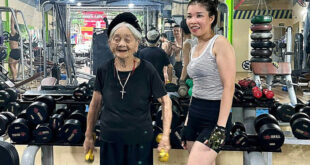It was 500 meters from the parking lot to the Ghenh Da Dia (The Cliff of Stone Plates) in central Phu Yen Province, and her group decided to walk, but not Xuan Ngan.
She hung back and waited for an electric tram. She was not the only visitor to prefer the tram to walking: Around her, a dozen others were also waiting for it, mostly young people.
“The electric tram is there for our convenience, why not use it?” the 30-year-old office worker in Hanoi asked.
Also last year, while visiting Lung Cu Flagpole (Ha Giang), instead of climbing the 300 steps, which might have taken her no more than 15 minutes, she decided to buy a tram ticket for VND30,000 ($1.26).
Her reluctance to undertake physical activity means she orders daily needs and food on apps though her home is less than a kilometer from shops. She orders food around 10 times a week on average.
 |
|
One rare case when Xuan Ngan climbed steps was in October 2022, when she visited a remote village in Ha Giang that could not be reached by motorbike. Photo courtesy of Ngan |
Diem My, 40, of Hai Phong always uses a motorbike to go to the market though it is less than 300 meters away.
Quoc Bao, her husband, has no issues with that since she often has urgent work to do or carry a lot of stuff after shopping. But she does the same even to buy a roll of toilet paper or toothpaste.
Sometimes she tells her son to buy a pack of spice in a lane right beside their house, and reminds him to use the electric bike.
Bao said with a sigh: “The grocery shop is only 100 meters from our house. For that distance, walking is even faster. How can our son be physically active if his mother is like that?”
Son drives a motorbike-taxi in Hanoi’s Soc Son area near the Saint Giong statue, and the increasing laziness among young people means he earns more money these days. In the past many people would simply walk up to the monument to take in the views.
During crowded times like Lunar New Year holidays (Tet), he gets a dozen fares a day and earns up to VND1 million. Food delivery apps have become all the craze, with people reluctant even to go down to their local food shop for a quick bite.
The owner of a Western food restaurant in Hoan Kiem District in Hanoi said on average he gets more than 200 online orders every day.
“I am surprised to see many customers order delivery to their houses just a few hundred meters away.”
Health experts warn that dependency on technology will affect people’s health.
According to the United Nations Population Fund, Vietnam is among the top 10 countries in the world for rate of inactive people.
A study by the Ministry of Health’s department of preventive medicine found that 30% of Vietnamese adults do not engage in physical activities.
A 2019 study by the National Institute of Nutrition found the average Vietnamese person only walked 3,660 steps per day, while office workers walked only 600. WHO recommends people should walk 10,000 steps.
In 2021 data from the General Department of Physical Education and Sports showed in fact that the rate of people doing physical training and participating in sports was low.
Only around 35% exercised regularly.
Dr Quan The Dan, deputy director and head of the emergency and intensive care department at Tri Duc Thanh General Hospital in Thanh Hoa province, said lack of physical activity leads to many health risks such as obesity, high blood pressure and diabetes. It is one of the reasons why the death rate from non-communicable diseases is 74%.
Researcher Nguyen Anh Hong said this phenomenon of physical inactivity has existed for thousands of years and pointed to four key reasons for Vietnamese not engaging in regular physical exercise.
Firstly, unlike people living in grasslands and deserts, Vietnamese live in a wet rice civilization adapted to hunting and gathering rather than physically demanding tasks.
Secondly, they are reluctant to go far since they typically live in tiny communities in villages and hamlets.
Thirdly, they are not well-suited to physical activity due to their small stature and lack of muscle mass.
Fourthly, they tend to move less to conserve energy.
While acknowledging it as a “historical legacy” Dan said however it is no longer valid since living standards have improved as have people’s physical ability and endurance.
Diem My’s son has become lazier, complaining when he has to walk even very short distances to a grocery shop or from his school gate to classroom. “Maybe I should try to change his habits,” My said.
Ngan’s lack of exercise causes her to tire easily, not sleep well and have shortness of breath and heart palpitations when climbing stairs. She is at risk of obesity.
“My doctor advises me to exercise at least 30 minutes a day, but I don’t have the time or energy since I work from morning to night. If I want to lose weight, my only way is to diet or use supplements.”
 |
|
People cycle near West Lake in Hanoi in August 2022. Photo by VnExpress/ Quynh Nguyen |
Dan said everyone should improve their lifestyle by eating less fatty and sugary foods and exercising more.
“First, people must improve their awareness. Only if they understand the benefits of exercise can they engage in it.”
At 7 a.m. every day, Thanh Tung of Hai Phong leaves for work on his bicycle. The 40-year-old has chronic neck, shoulder and back pains as a result of his office job.
When he tried cycling and walking he realized they gradually went away. Realizing the effects, he has been cycling to work since 2019. In office, he uses the stairs instead of elevators as another means of exercise.
He said: “With limited time for exercising due to my busy schedule, I do this. Not only have I cured the health problems caused by office work, but also feel both my physical and mental health have improved, and I eat and sleep better.”
- Reduce Hair Loss with PURA D’OR Gold Label Shampoo
- Castor Oil Has Made a “Huge” Difference With Hair and Brow Growth
- Excessive hair loss in men: Signs of illness that cannot be subjective
- Dịch Vụ SEO Website ở Los Angeles, CA: đưa trang web doanh nghiệp bạn lên top Google
- Nails Salon Sierra Madre
 VnExpress News The News Gateway of Vietnam
VnExpress News The News Gateway of Vietnam





